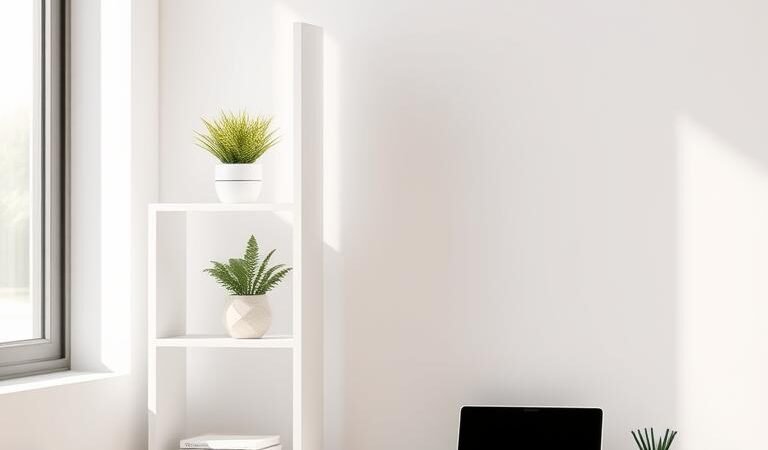Living in a well-ordered space can change how you feel every day. Too much clutter often leads to stress, making it hard to focus. A tidy home, on the other hand, brings calm and clarity.
Many people struggle with keeping their surroundings neat. The good news? Small steps can make a big difference. Start with one drawer or shelf, and soon, you’ll see progress.
This guide shares practical ways to create a peaceful, functional home. Whether you’re tackling a single room or your entire house, these tips will help. The goal is to make your space work for you—not the other way around.
Key Takeaways
- A tidy home reduces stress and improves focus.
- Starting small makes the process manageable.
- Intentional choices lead to lasting results.
- Practical systems help maintain order.
- Documenting progress keeps motivation high.
Why Decluttering Transforms Your Home and Mind
Ever notice how a messy room makes your mind feel just as crowded? Research shows clutter isn’t just a visual problem—it directly impacts mental clarity and daily efficiency. By curating your surroundings, you create room for calm and purpose.
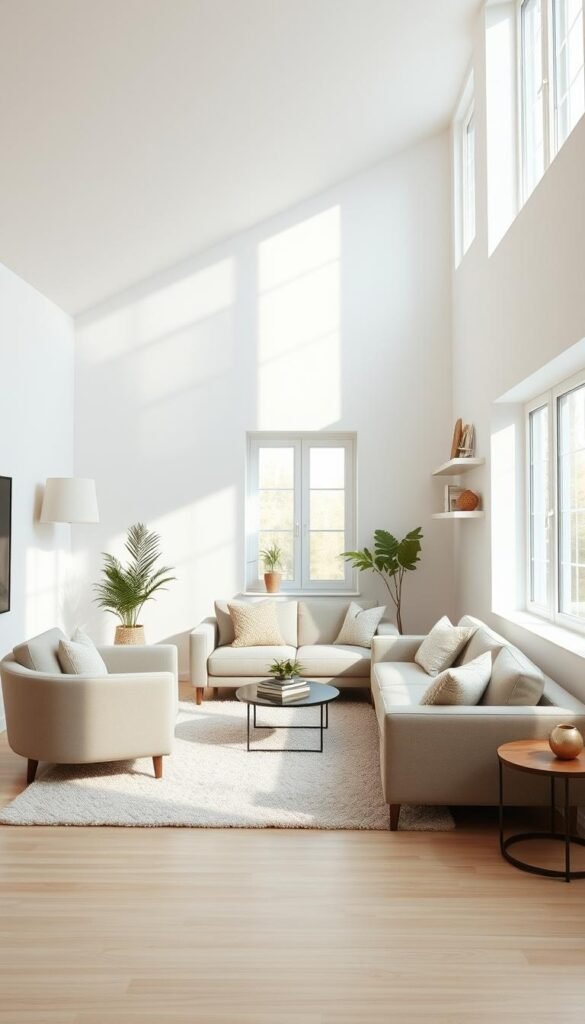
The Mental Health Benefits of a Clutter-Free Space
Clutter triggers cortisol spikes, the hormone linked to stress. UCLA studies tracked stress levels in cluttered versus organized homes. Participants in tidy spaces had 20% lower cortisol throughout the day.
Visual noise—like piles of unsorted mail or crowded shelves—overloads the brain. This leads to decision fatigue. Neuroscientists found that clearing just one surface (like a kitchen counter) reduces morning anxiety by 30%.
How Clutter Affects Productivity and Focus
Princeton University discovered workers in clean spaces perform tasks 15% faster. Excess items create distractions, forcing the brain to process unnecessary stimuli. A minimalist workspace, however, fosters deep focus.
| Cluttered Space | Tidy Space |
|---|---|
| 43% longer task completion | Higher accuracy rates |
| Frequent interruptions | Sustained concentration |
| Lower sleep quality | Faster relaxation at bedtime |
Try “clutter journaling” for a week. Note how different areas make you feel. A cleared nightstand might improve sleep, while an organized entryway eases morning rushes. Small changes yield big emotional rewards.
Minimalist Mindset: Shifting Your Relationship with Stuff
The weight of unused belongings often holds more than dust—it carries emotional anchors. Reevaluating what stays in your space isn’t just about tidiness; it’s a conversation with your past and future self.

Letting Go of Sentimental Items Without Guilt
Keepsakes tie us to cherished moments, but not all deserve a forever home. Try the memory distillation technique: photograph items, then donate the physical object. A single quilt square can hold as much meaning as the entire blanket.
For family heirlooms, create a rotation system. Display one piece per season—this honors history without overcrowding. Ask: “Would this still matter to my descendants in 100 years?” If not, it’s okay to pass it on.
Embracing the “Less is More” Philosophy
Japanese mottainai (a regret for waste) teaches respect for objects without hoarding. Contrast this with Western consumerism, where excess is routine. Apply museum curation principles: if it doesn’t spark joy or serve purpose, it’s clutter.
- Scarcity vs. abundance: Fear of “not enough” fuels clutter. Focus on what you truly use.
- Possession obituaries: Write a brief goodbye note to items you release. Acknowledge their role, then let go.
- Small wins: Start with a single drawer. Confidence grows with each cleared space.
Minimalism isn’t emptiness—it’s designing a life where every thing has intention. The love idea behind objects matters more than their quantity.
Declutter and Simplify: A Minimalist Approach to Organization
Many believe that buying more storage bins solves clutter—but the opposite is often true. Real home organization begins with reducing what you own, not rearranging it. This section reveals why traditional methods fail and how minimalist principles create lasting order.
The Core Principles of Minimalist Decluttering
The mantra “you cannot organize clutter” changes everything. True decluttering organizing means removing excess, not hiding it. Start with these rules:
- Horizontal surface liberation: Flat spaces (tables, counters) should stay 80% clear. This reduces visual stress.
- 5:1 ratio: For every five stored items, only one deserves display. Be ruthless with duplicates.
- Access frequency matrix: If you haven’t used something in 90 days, it’s likely clutter.
Why Traditional Storage Solutions Fail
Clear bins and drawer dividers often enable hoarding. The container fallacy tricks us into keeping things we don’t need. Compare 1900s homes—with 40% fewer possessions—to today’s crammed closets.
| Traditional Approach | Minimalist Solution |
|---|---|
| Buys bins for “stuff” | Removes items first |
| Relocates clutter | Eliminates it permanently |
| Focuses on storage | Focuses on access and use |
Ask: “Does this solve the problem or just move it?” Real freedom comes from owning less—not organizing more.
Start Small: The Junk Drawer Method
That one chaotic drawer in every home holds more than loose change—it’s a gateway to organization. Packed with random things, this space reflects broader clutter patterns. Tackling it first builds confidence for larger projects.
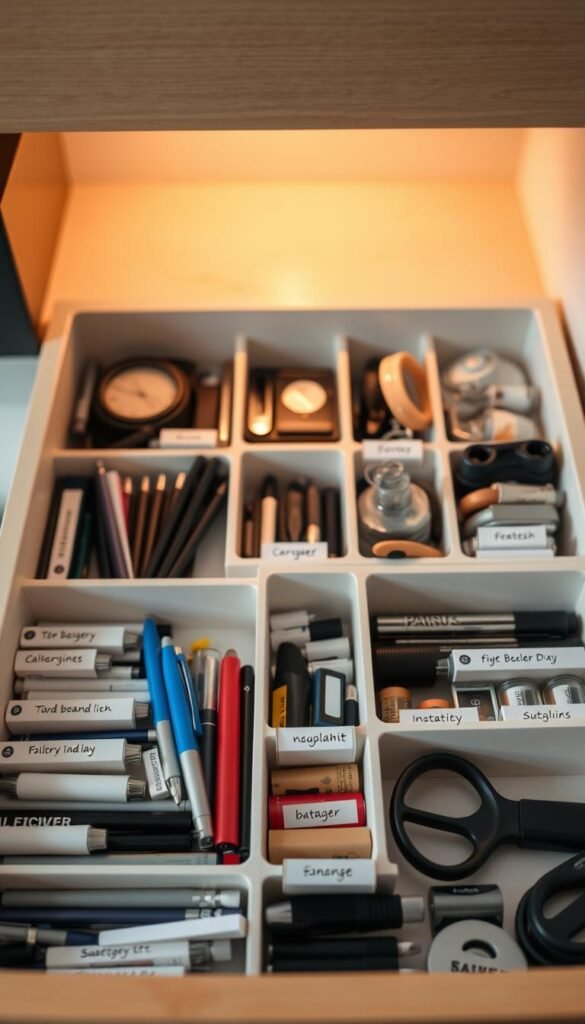
Why the Junk Drawer is the Perfect First Step
Junk drawers are universal. They contain a microcosm of household clutter—batteries, receipts, and tangled cords. Starting here offers a quick win. The small scale makes the process less overwhelming.
Try category triage: Set a timer for 5 minutes. Sort items into piles like “tools,” “paper,” and “miscellaneous.” This reveals what’s truly useful. Assign each a utility score (1–5) based on how often you use it. Scores below 3? Toss or donate.
Step-by-Step Process for a 15-Minute Win
- Empty it: Dump the drawer onto a clean surface. Wipe the interior.
- Zone it: Use dividers for categories (e.g., “office supplies” left, “tools” right).
- Repurpose: Turn old mint tins into battery holders or paperclip containers.
After decluttering, perform a drawer autopsy. Note what accumulated—maybe too many takeout menus. This insight helps prevent future clutter. Finally, stick to a monthly maintenance checklist:
- Discard expired coupons
- Return stray items to their real homes
- Re-evaluate utility scores
The KonMari Method: Sparking Joy Room by Room
Marie Kondo’s philosophy transforms homes by asking one simple question: Does this spark joy? Unlike traditional decluttering, her method focuses on intentionality—keeping only what resonates deeply. This approach creates spaces that feel alive, not just tidy.
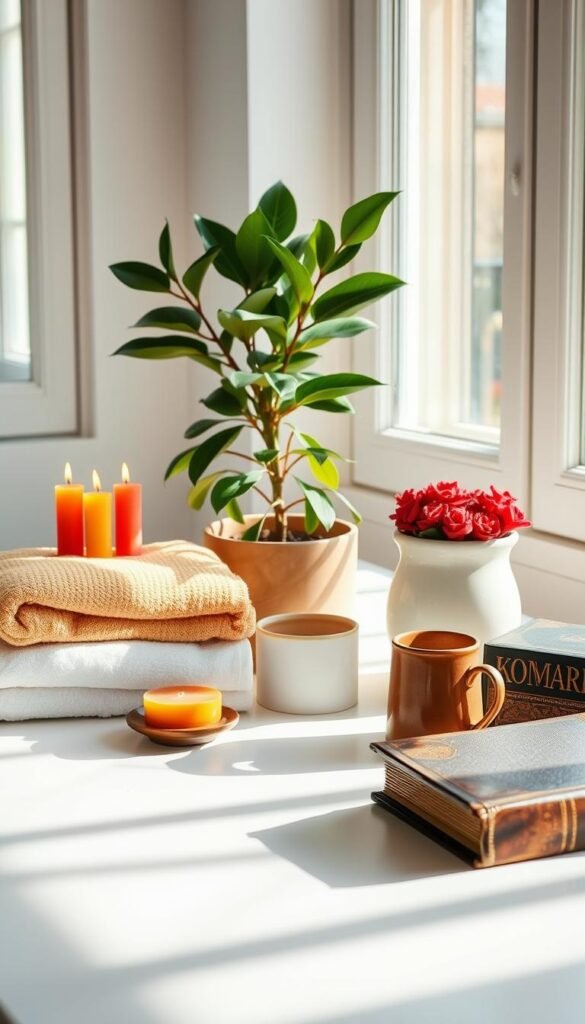
How to Apply Marie Kondo’s Category System
The KonMari sequence—clothes, books, papers, miscellaneous, sentimental—works because it builds confidence. Start with easier categories like clothes before tackling emotional items. Here’s how to adapt it:
- Decode “spark joy”: Hold each item. Notice if your breath deepens (joy) or shoulders tense (clutter).
- Cultural tweaks: Western homes may need more sentimental pauses than Japanese implementations.
- ADHD-friendly: Use “joy mapping”—assign colors to categories for visual progress tracking.
| Traditional Sorting | KonMari Approach |
|---|---|
| Room-by-room | Category-by-category |
| Speed-focused | Emotionally intentional |
| Keeps “useful” items | Keeps only joy-sparkers |
Handling Sentimental Items with Compassion
Sentimental items require gentler rules. Try ceremonial letting-go: Thank objects aloud before donating. For heirlooms, preserve one representative piece (e.g., a single letter, not the entire box).
Research shows KonMari practitioners maintain 70% of their progress after two years. The secret? Joyful spaces naturally resist recluttering. Every kept item becomes a conscious choice, not a default.
Swedish Death Cleaning: A Long-Term Perspective
Swedish death cleaning isn’t about endings—it’s a thoughtful gift to those left behind. This Scandinavian practice, called döstädning, encourages reviewing possessions through the lens of legacy. It transforms clutter into curated meaning.
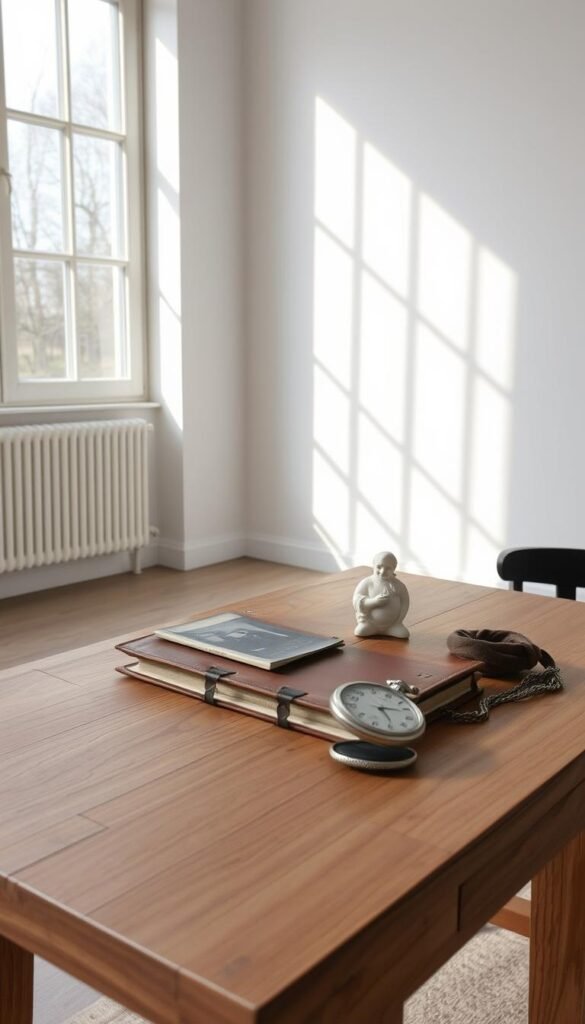
Questions to Ask About Every Item
Margareta Magnusson’s philosophy suggests evaluating objects with future generations in mind. Try these prompts when sorting:
- Legacy labeling: Tag heirlooms with sticky notes explaining their significance (“Grandma’s wedding china, 1942”).
- Digital executor: Designate someone to manage online accounts and cloud storage.
- Five-generation test: Ask if this will matter to descendants in 2123. Most things won’t.
| Traditional Approach | Swedish Death Cleaning |
|---|---|
| “Someone will want this” | “Would I buy this today?” |
| Keepsakes stored indefinitely | Selected items with documented stories |
| Last-minute decisions | Annual reviews starting at age 50 |
Reducing Future Burdens for Loved Ones
Ashley Knierim’s checklist helps prevent inheritance stress. Schedule possession legacy talks with family during holidays. Discuss:
- Which items hold true sentimental value
- How to divide collections without conflict
- Where to donate specialized items (like vintage tools)
This practice isn’t morbid—it’s a celebration of life well-lived. A pared-down home becomes a map of your values, not just your possessions.
The 4-Box Decluttering System for Quick Decisions
Four boxes can transform overwhelming choices into clear actions. This method cuts through decision fatigue by creating physical boundaries for your items. No more endless “maybe” piles—just crisp categories that force clarity.
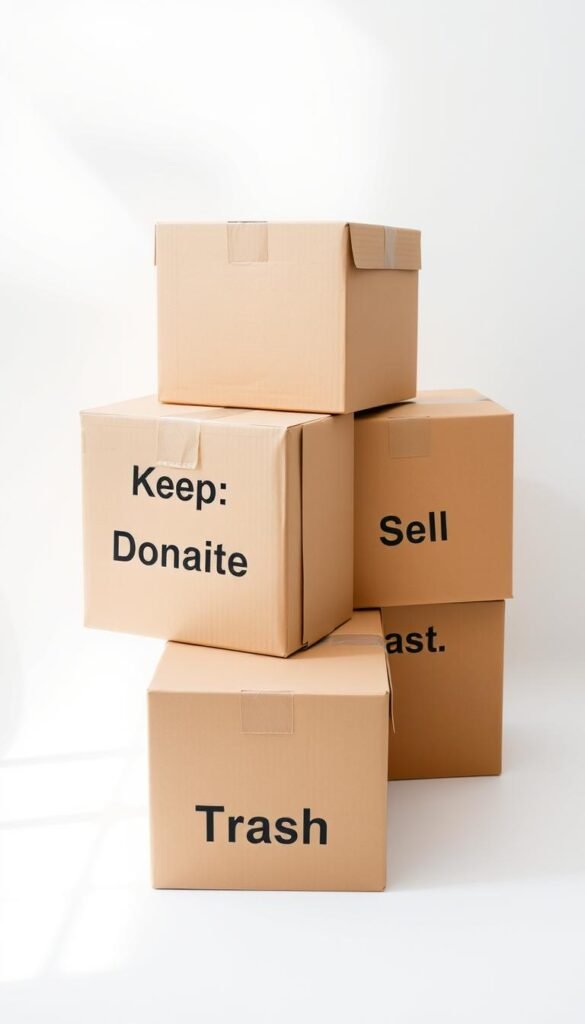
Setting Up Donate/Sell, Trash, Recycling, and Keep Boxes
Color-coding taps into visual processing. Try these combinations:
- Donate/Sell (Green): For things with residual value
- Trash (Black): Broken or unusable items
- Recycling (Blue): Paper, plastic, and metals
- Keep (White): Only essentials that serve purpose
Pro tip: Use translucent bins. Seeing contents reduces “out of sight, out of mind” rebound clutter. A study by Container Store shows this cuts recluttering by 40%.
What to Do When You Can’t Decide (The Penalty Box)
Create a fifth box for indecisive items. Label it with a deadline—two weeks max. Research shows 80% of penalty box things never get retrieved. This makes “get rid” decisions automatic.
| Box Type | Action Timeline |
|---|---|
| Donate/Sell | 48-hour listing window |
| Trash/Recycle | Immediate removal |
| Penalty Box | 14-day expiration |
For high-value items, calculate resale ROI. That $200 blender? If it sells for $15 after fees and effort, recycling may be smarter. Apps like Decluttr automate this process.
Schedule box rotations every season. Empty all containers—even keepsakes—to reassess their value. This prevents storage spaces from becoming clutter graveyards.
Room-by-Room Decluttering Strategies
Each room in your home serves a unique purpose—your decluttering strategy should too. Kitchens buzz with activity, closets guard daily choices, and living rooms host relaxation. Tailored approaches ensure these spaces stay functional and serene.
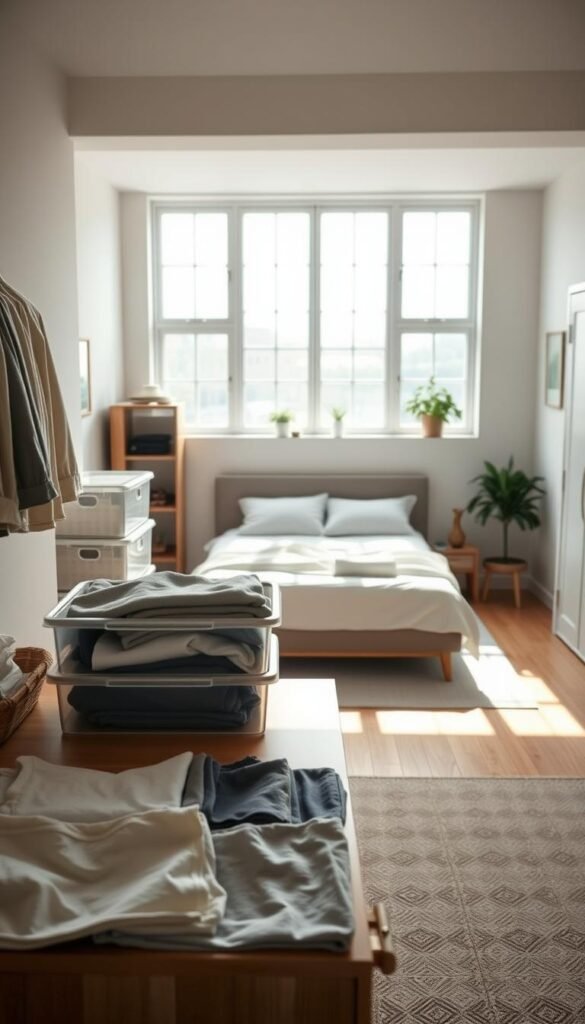
Kitchen: Tackling Unitaskers and Duplicates
The kitchen thrives on efficiency. Start with the triangle of efficiency—clear paths between fridge, stove, and sink. Cluttered countertops slow cooking; keep only daily-use appliances. Perform an appliance autopsy:
- Unitaskers (avocado slicers, egg boilers) rarely earn their space. Donate or recycle.
- Duplicates (three cheese graters?) keep one quality version.
- Expired spices and stale pantry items? Toss without guilt.
Closet: Project 333 for a Capsule Wardrobe
A closet should feel like a curated boutique, not a storage unit. Project 333 simplifies choices: 33 clothes items for 3 months. Build a palette around three neutrals (e.g., navy, white, gray) and two accents. Tips:
- Hang clothes by category, then color—visually calming.
- Store off-season wear out of sight.
- Donate anything untouched in 6 months.
Living Room: Clearing Flat Surfaces
Flat surfaces attract clutter like magnets. Adopt surface zero—clear tables and shelves nightly. Use decorative trays to corral remotes or books. For deeper home organization, try the monthly focus area system, rotating attention between zones.
| Problem Area | Quick Fix |
|---|---|
| Overstuffed coffee table | Limit to 3 decorative items + 1 functional (coasters) |
| Tangled cables | Use binder clips under desks |
| Piled magazines | Digital subscriptions or recycle after reading |
Digital Decluttering: Organizing Your Virtual Life
Digital clutter weighs just as heavily as physical messes—it just hides behind screens. Unanswered emails, duplicate photos, and unused apps create invisible stress. Tackling this digital life cleanup frees up mental space and device performance.

Simplifying Email and Cloud Storage
The inbox zero-mindful messaging hybrid works best. Process emails in batches—respond, archive, or delete immediately. Set digital possession caps:
- 100 saved emails max per folder
- Cloud storage seasonal rotation: Review files quarterly like wardrobe swaps
- App permission audit: Remove unused access monthly
Cable clutter exemplifies forgotten things. Label cords with washi tape or recycle unused chargers. For cloud storage, create a process:
- Sort files by year
- Archive older than 3 years externally
- Delete duplicates with tools like Gemini 2
Reducing Screen Time Clutter
Notifications are the junk mail of your phone. Create a hierarchy—only allow alerts for:
| Priority | Examples |
|---|---|
| Critical | Texts, security alerts |
| Optional | News apps after 5PM |
| Never | Social media likes |
Track your attention budget like finances. Apps like Moment show where time disappears. For ultimate clarity, prepare a digital will—list passwords and desired data preservation.
Maintaining a Decluttered Home
A clutter-free home isn’t a one-time project—it’s a lifestyle shift. Without systems, things slowly accumulate again. The key? Tiny, consistent habits that protect your peaceful spaces.
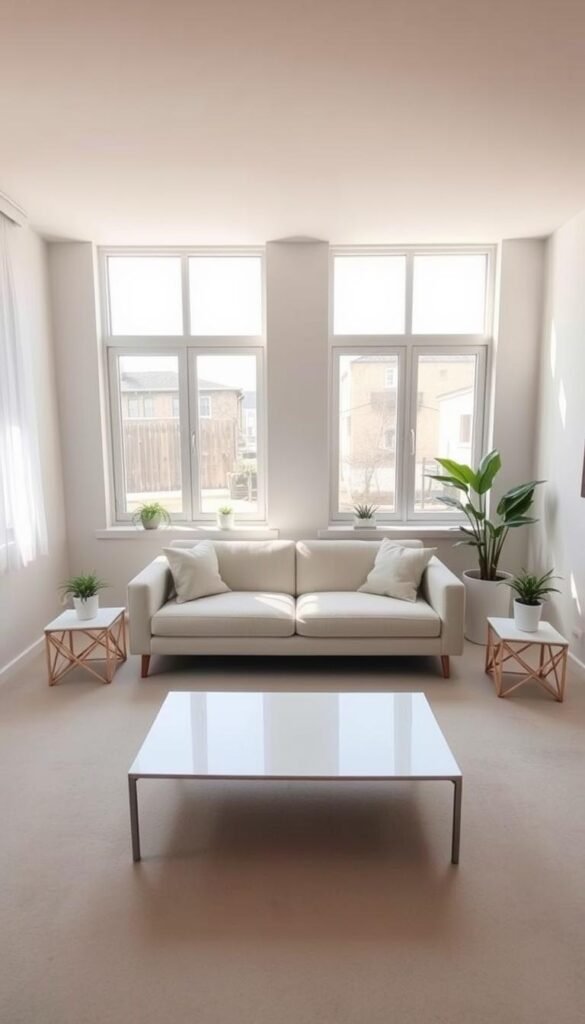
The “One In, One Out” Rule
This simple policy balances your possessions. For every new item entering your life, one must leave. Try these tweaks:
- Upgrade swaps: Replace worn-out things with better versions (e.g., donate old towels when buying new ones).
- Shopping permission slips: Write down why an item is needed before purchasing. No justification? No buy.
- Reverse shopping: Each season, “return” unused items by donating them.
Monthly Mini-Declutter Challenges
Set 15-minute tasks to stay ahead:
| Challenge | Focus Area |
|---|---|
| Drawer dash | Clear one drawer weekly |
| Fridge Fridays | Discard expired foods |
| Surface rescue | Keep counters 80% clear |
Track progress with an entropy chart on your fridge. Color-code zones by clutter level—green (tidy) to red (needs attention). Families can hold 10-minute “clutter check-ins” to reassess problem areas.
When relapse happens, restart small. A single cleared shelf rebuilds momentum. Remember: Maintenance is the quiet hero of an organized home.
Tools and Resources to Keep You Motivated
The right tools turn organization from a chore into a rewarding journey. Whether you thrive on visual inspiration or structured plans, curated resources can sustain momentum. Below, discover books, videos, and systems tailored to your style.
Curated Learning for Every Personality
Decluttering isn’t one-size-fits-all. Match resources to your preferences:
- Visual learners: Explore YouTube channels like Minimalist Mom for room makeovers.
- Readers: Try books by Margareta Magnusson or Marie Kondo for philosophy + steps.
- Audio fans: Add A to Z Minimalism podcast episodes to your playlist.
| Resource | Best For | Key Feature |
|---|---|---|
| The Gentle Art of Swedish Death Cleaning | Sentimental items | Legacy-focused approach |
| Clutterbug YouTube | Organizing styles | Humor + practical hacks |
| Project 333 Challenge | Capsule wardrobes | 3-month clothing limits |
Printable Checklists for Tangible Progress
Printable checklists break tasks into bite-sized wins. Try these:
- 30-Day Declutter Calendar: One small area daily.
- Donation Tracker: Log items released (with weight-to-freedom conversions).
- Maintenance Map: Color-coded zones for weekly touch-ups.
Pair checklists with an accountability buddy. Share screenshots of completed tasks—celebrating progress fuels motivation. For a creative twist, craft a vision board with organization goals using magazine cutouts or Pinterest saves.
Conclusion: Your Clutter-Free Life Starts Today
Your home should feel like a sanctuary, not a storage unit. Perfection isn’t the goal—progress is. Try the 30-second domino challenge: remove one item from your desk or fridge. Notice how it creates momentum.
Visualize your life six months from now. What legacy do you want your spaces to reflect? Organization osmosis works gradually—tiny habits, like clearing a nightstand daily, compound into big change.
Write a personal declaration: “I choose spaces that fuel my best self.” Tape it where clutter gathers. Remember, every cleared surface is a win. Start now—your future self will thank you.
